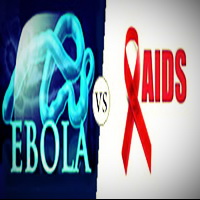Difference between Ebola, Aids / HIV and Zika virus

Do you know due to EBOLA, over 4,000 deaths have occurred in West Africa? Yes! It’s on the nerves nowadays which is now topped with 8,000 according to the CDC. U.S Centers for Disease Control and Prevention (CDC) has taken this virus seriously and articulated: “We have to work now so that this is not the world’s next AIDS.” This post will reveal the difference between Ebola, Aids / HIV, and Zika virus.
What is EBOLA Virus Disease (EVD)
EBOLA virus is known as hemorrhagic fever is a disastrous illness in humans caused by pollution and wild animals via human-to-human transmission. Average Ebola virus disease is around 50% according to the statistical scale.
What is AIDS / HIV
AIDS stands for Acquired Immunodeficiency Syndrome which is a deadly disease caused by human immunodeficiency virus (HIV).
What is Zika virus
Zika virus is a viral disease caused by mosquitoes that bite at day time called Aedes mosquitoes (it is also known as yellow fever mosquito). Zika virus is spread through the bite of an infected Aedes mosquito.
https://researchpedia.info/health-is-a-blessing-how/
EBOLA vs AIDS / HIV vs Zika virus
Variance in Transmission
EBOLA is easily transmissible through bodily fluids mainly of animals through human to human transmission whereas AIDS is transmitted through sexual discourse, blood, and breast milk. EBOLA is easier to spread where aids have multiple chances to spread. Both viruses originated in Africa and medical science is acting seriously for its demolition. Whereas the Zika virus is first and foremost transmitted by the bite of an infected Aedes mosquito which usually bites during the daytime. Other transmission routes of Zika virus are:
It can be transmitted during blood transfusion
It is transmitted from mother to her fetus during pregnancy months
It can be transmitted through sexual contact
It can also transmit during organ transplantation.
Symptoms
EBOLA time span of displaying symptoms is shorter than 21 showing the symptoms of infection from 8-10 days. Here are the following symptoms:
Profuse Bleeding
Fever
Diarrhea
Vomiting
Abdominal Pain
Contrary, HIV/AIDS has a long duration to stand. Sometimes the victim doesn’t flaunt any symptoms till 10 years or months. In the time span, patients can be asymptomatic for most of the time months and years. In both cases, symptoms existence is a must to be contagious.
On the other hand, the Zika virus shows mild or moderate signs and symptoms which lasts for only days to weeks. Which is why many patients don’t notice that they have been infected.
Following are the sign and symptoms of Zika virus:
Asymptomatic – Many patients shows no sign and symptoms
Temperature – Patient will show low-grade fever or mild fever (temperature above normal but below 100.4 F or 38 C)
Rashes – Patient develops small red bumps and reddish spots on the body (trunk, face, legs, arms, palms, and soles)
Neurological symptom – Patient will suffer from headache
Musculoskeletal symptoms – Patient develops joint pain (also swelling of small joints of feet and hand), muscle pain and lower back pain
Eye symptom – Patient’s eyes become red and inflamed (conjunctivitis) and he will feel pain behind his eyes
Itching – Patients may also develop itching problems.
Time Span
Ebola has a shorter latency period and high visibility than HIV/AIDS. Patients die typically between 6 and 16 days of complications. On the other side, the virus that contains the AID/HIV virus has a long incubation period and low visibility as symptoms usually not outwardly seen. Whereas the incubation period (the time from a mosquito bite to the development of symptoms) of Zika virus disease is approximately 3 to 14 days. Symptoms may last about four days to one week.
Catastrophic Presentation of Viruses
Ebola virus kills the victim by causing hemorrhaging or following failure of organ or septic shock. On the other side, considering HIV/AIDS it kills the victim indirectly by lowering the immune system. In this way, it inclines to deadly infections with the non-involvement of the virus. CDC reports it is apparently like AIDS but more fatal. Whereas in Zika virus serious patients may develop complications such as:
Bleeding
Shock (a condition in which your blood pressure falls)
Guillain- Barre syndrome (it is a serious neurological (autoimmune) disease that affects your nerves causing numbness and weakness in your body especially in arms, hands, legs, and feet) generally patients recover from this disorder but it may cause the death of 1 percent patients.
Does Medical Science own treatments
In all three cases, no FDA approved vaccinations are available. Although several vaccinations are under development are currently being evaluated in Phase I. Thereby, recommended care must be taken by the patient including volume repletion, nutrition support, and maintenance of blood pressure. There is no specific antiviral treatment for the Zika virus.
Patients get symptomatic treatment such as:
General treatment – lots of fluids, complete bed rest, and a healthy diet.
Medical treatment – Paracetamol such as Acetaminophen (Tylenol – which relieves your joint pain and fever).
https://researchpedia.info/foods-that-help-you-against-inflammation/
Conclusion
Concluding the difference between Ebola virus, AIDS/HIV, and Zika virus. The Ebola virus disease case fatality rate is around 50 percent. According to studies case fatality rate of microcephaly associated with the Zika virus is 8.3 percent. In AIDS/HIV patients who receive HAART (highly active antiretroviral therapy) treatment will survive for more than 10 years, whereas those patients who do not receive HAART die within 2 years of the onset of AIDS.
References:
https://my.clevelandclinic.org/health/diseases/15606-ebola-virus-disease/outlook–prognosis
https://www.cdc.gov/vhf/ebola/diagnosis/index.html
https://www.who.int/news-room/fact-sheets/detail/ebola-virus-disease


Leave a Reply